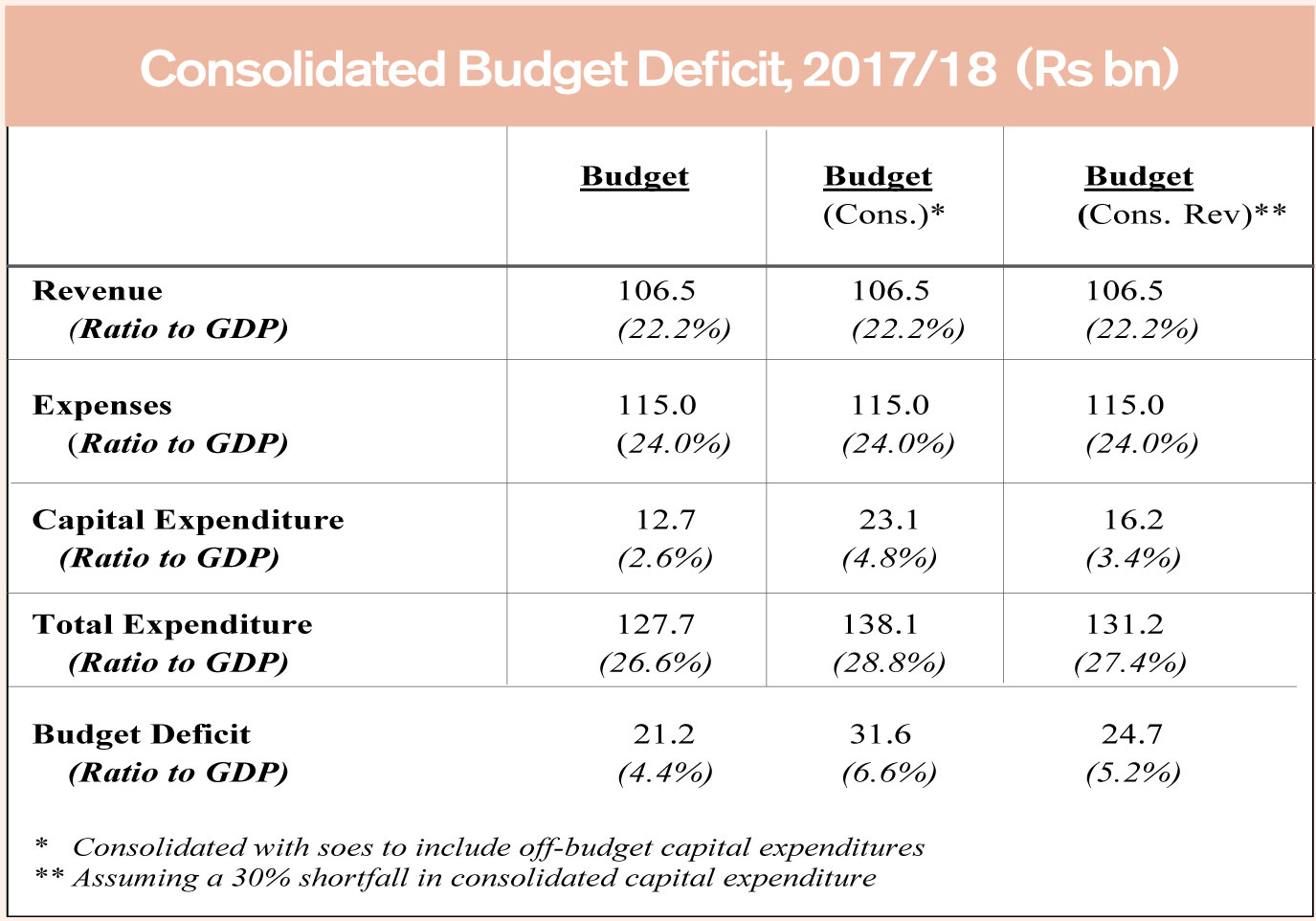Publicité
2017/18 Budget: Serious Risks Ahead
Par
Partager cet article
2017/18 Budget: Serious Risks Ahead

The 2017/18 budget has raised expectations of a major economic transformation, driven by distinctive policy changes and an ambitious public investment programme, to set the country firmly on the path to high income status. Investments and growth will be boosted mainly by the implementation of Metro Express, a massive project to spearhead the modernization of public infrastructure, and through further tax inducements for private real estate development.

Widening budget deficit
Chronic budget deficits, and a sharp deterioration of the budget outcome in 2017/18, are generating significant threats to fiscal soundness and sustainability. The budget deficit in 2016/17 stands at Rs 15 billion, or 3.4% of GDP, and is lower than originally estimated despite a revenue shortfall, due to sizeable under-spending.
In 2017-18, the budget deficit is estimated to widen to 4.4% of GDP. The official deficit estimate of 3.2% of GDP is understated, because the transfer of balances of Rs 5.7 billion upon the closure of two special funds should not be considered as revenue. Just as drawing on the savings balance does not enhance a household’s income, but only serves to finance excess spending. The operating deficit shot up in 2015/16, and is budgeted to rise further to 1.8% of GDP in 2017-18, compared to only 0.7% in 2014.
The proposed routing of the Indian line of credit of USD 500 million, through the State Bank of Mauritius, to finance offbudget expenditures by state owned entities (SOEs) would also result in an underestimation of the budget deficit and of public debt. Off-budget spending in SOEs is another version of the previous recourse to extra budgetary funds.
A consolidation of the budget with these SOEs is necessary to derive a correct measure of the fiscal balance. Off-budget capital expenditures in SOEs in 2017- 18 amount to Rs 10.4 billion, or 2.2% of GDP, as illustrated in the diagram. Besides Metro Express, the other SOEs relate to Landscope, NHDC, Water Development Co., and CEB Green Energy.
Budget consolidation with these SOEs would imply a heavier deficit of 6.6% of GDP in 2017/18. Assuming a realistic 30% shortfall in capital expenditures, the revised consolidated deficit would be Rs 24.7 billion, or 5.2% of GDP. The soaring deficit presages aggravated risks for the soundness of public finances, and for debt sustainability. The budget is formulated in a 3-year, macro-economic and strategic framework. The 2017/18 budget is a baseline exercise, to be assessed in conjunction with budget projections for the next two years. The budget deficit is planned to decline to 2.8% of GDP by 2019/20, excluding off-budget spending, through measures “to enforce greater fiscal discipline and prudence”, including scaling back expenditure growth.
But, in effect, the medium-term budget framework embodies a simple add-on to the current budget to backload fiscal adjustments in future years. Moreover, projections of fiscal consolidation do not adequately reflect adjustment needs.
Restrained capital spending
Stronger capital spending is needed to stimulate investment and growth. The growth of real GDP at market prices is estimated at 4.1% in 2017/18, which is marginally higher than the rate of 3.9% in the previous year. The investment rate would gain slightly from 17.6% to 18.8% in 2017-18.
The 2017-18 budget provides a modest stimulus for investment and growth. By 2019/20, the investment and GDP growth rates are expected to improve further to 21.7% and 4.5%, respectively. A shrinking labor force and weak productivity gains pose serious challenges to meeting the ambitious targets required to avoid the middle-income trap and turn into a high-income economy.
In 2016/17, capital spending stood at Rs 8.4 billion, substantially lower than budgeted by Rs 6.4 billion, or a shortfall of over 40%. Capital spending in 2017/18 is budgeted at Rs 12.7 billion, or 2.7% of GDP. Including off-budget capital expenditures of Rs 10.4 billion in SOEs, consolidated capital spending would total Rs 23.1 billion, or 4.8% of GDP. Estimated expenditures of Rs 8.6 billion by Metro Express, account for 85% of off-budget capital expenditures, or over a third of total capital spending in 2017/18.
It is most probable, however, that capital spending will witness a shortfall in 2017/18, as in previous years. Assuming lower capital spending by 30%, consolidated capital expenditures would stand at Rs 16.2 billion, or 3.4% of GDP in 2017/18. A desirable target for budgetary capital spending is closer to 5% of GDP.
An extra boost to public investments would further stimulate the economy and compensate for the weakness in private investments. To accelerate capital spending while maintaining sustainable budget deficits, operating expenses must however be kept in check.
Surging expenses and total expenditures
The unbridled expansion in budgetary current and total spending is also heightening fiscal vulnerabilities. Expenses are on an expansionary trend since 2015/16, increasing by an average of Rs 10 billion annually, and are estimated to climb to 24% of GDP in 2017/18, or 2.5 percentage points higher than in 2014.
A strong emphasis on pensions and social spending, and an inflating pay bill have driven the surge in operating expenses. The imbalance between operating and capital expenditures has accentuated sharply. Expenses averaged around 6 times capital spending between 2010 and 2014, but this multiple has doubled since.
In 2015/16, total expenditures fell relative to the GDP, owing to a sharp cut in capital spending. Following a modest recovery of capital spending, total expenditures are projected to reach a record 26.6% of GDP in 2017/18. Inclusive of off-budget expenditures, but assuming a capital spending shortfall of 30%, total expenditures would represent 27.4% of GDP, or about 2.3 percentage points higher than in 2014. These escalating levels of public spending are not sustainable over the medium term. Fundamental policy adjustments for fiscal consolidation will become inevitable, through hikes in taxation, and curbs on expenditures.
The efficient management of public expenditures remains of critical importance. The 2015 budget discarded program based budgeting to revert to a dual budgeting approach based on separate recurrent and capital budgets. The shortcomings of this outdated approach are well known, in terms of inadequate control and poor resource allocation.
The proposed setting up of a Public Investment Management Unit at the Ministry of Finance to appraise project proposals and monitor implementation should lead to improvements in the selection and execution of public investments. The 3-year strategic plan is a useful document, but its key actions and related key performance indicators are poor substitutes for a full-fledged program budgeting framework.
Mounting public debt
The continued aggravation of the public debt burden raises sustainability and solvency risks, and weakens the potential for economic growth. Public indebtedness has deteriorated progressively in recent years, stemming from high budget deficits and capital injections into Maubank, despite sizeable loan reimbursements from the CEB and the Build Mauritius Fund.
Public sector debt, defined to comprise the gross debt of General Government and selected public enterprises, worsened from 60.7% of GDP at Dec 2014, to an estimated 66.1% of GDP at June 2017. Public sector debt, on the local definition under the Public Debt Management Act, rose to an estimated 57.5% of GDP at the end June 2017, well above the statutory ceiling target of 50% of GDP.
The projected reduction in the public sector debt ratio to 63% by June 2018 is unrealistic, in view of the continued expansionary spending and the widening deficit. It is likely that the statutory debt target of 50% of GDP will be missed once again in Dec 2018, as in 2013.
Moody’s, the credit rating agency, reports that Mauritius has “a relatively high government debt ratio of 60% of GDP”, compared to its peer countries. Moody’s debt measure relates only to the General Government debt ratio, which has risen from 55.3% in December 2014 to 60% in March 2017. Moody’s also notes a redeeming feature in that public debt is mostly domestic.
Government is proposing to amend the Public Debt Management Act to provide for a new definition, target and timeline for public sector debt, effective from July 2017. It is important in this amendment to thwart any misgivings on the motive for abandoning existing statutory debt obligations. In addition, the integrity of our public debt reporting should be shielded from any doubtful accounting practices.
The channeling of the Indian line of credit of USD Rs500 million, representing 3.7% of GDP, through a subsidiary of the State Bank of Mauritius appears designed primarily to bypass Government and thus elude Government debt reporting. It is questionable whether this line of credit can be so summarily dissociated from Government, which will have to extend a guarantee for reimbursement.
The issuing of redeemable preference shares by state owned entities to finance offbudget expenditures also seems devised to understate public sector debt. However, redeemable preference shares are treated as equity under very strict conditions. Nonparticipating preference shares, whereby holders do not participate in the distribution of the residual value of a corporation on dissolution, are classified as debt by the IMF.
Contrived accounting to privilege form over substance does not serve the interests of financial transparency, and endangers the country’s solid reputation and credibility with international financial institutions and rating agencies.
Conclusion
Fiscal and debt sustainability concerns represent serious risks to financial stability and economic growth. Public indebtedness is stubbornly on the rise, and is approaching critical levels as the fiscal deficit widens. Crucially, the accumulation of public debt is associated with increased Government consumption rather than investment. Pensions and other social benefits are driving a surge in current expenses, close to 1% of GDP annually.
Substantial grant revenue will allow room for greater capital spending, mainly for the Metro project. However, the pursuit of more robust economic growth calls for an appreciably higher level of investments, as well as bolder policies to address the savings gap and other structural imbalances, and to raise overall productivity.
Future budgets will be pressed to administer a major restructuring, especially to provide the fiscal space to meet the external challenges arising from Brexit and the OECD/EU offshore tax avoidance initiatives.

Publicité
Publicité
Les plus récents






